The Truman Brewery development: The community reaches boiling point
In the first of a four-part series we look at why the Truman Brewery redevelopment was the last straw for many in the East End community being displaced by a wave of large-scale corporate development.
In September 2021, the approval of a vast commercial and retail complex on the site of the Old Truman Brewery, incited widespread protest, bringing to a boiling point a community’s long-simmering discontent with corporate-oriented regeneration.
Over the last fifteen years, under the guise of ‘regeneration’, a wave of large-scale private developments, primarily in the form of office blocks and luxury apartments, have sprung up in the western end of Tower Hamlets.
These megadevelopments have fanned the flames of the blazing inferno of rising house prices that are forcing swathes of lower-income residents from the East End.
Given the location of the proposed development, on the site of the historic brewery and at the heart of the immigrant community that forms Spitalfields and Banglatown, the battle over this application was highly symbolic, representing to many in the locale a battle for the area’s soul.
The heart of Spitalfields and Banglatown in the hands of the Zeloofs
The red brick chimney of the Old Truman Brewery dominates the skyline of Spitalfields and Banglatown.
In the latter stages of the 19th century, the chimney stood above one of Britain’s most substantial industrial concerns, and what was the world’s largest brewery at the time.
Towering above the brewery, the chimney stack is a relic of the East End’s industrial past. Yet, by 1995, the nine-acre site had lain derelict for six years.
A period of mismanagement by the Grand Metropolitan Group had sounded the death knell of a brewing business in operation since around 1666.
After this short vacancy, the plot was acquired by members of a garment baron family, the Zeloofs, who had originally moved to London from Israel via Iraq in the 1970s before building their business empire around Brick Lane.
The family had purchased the site for, what was, according to the now defunct local paper, the East End Enterprise, an ‘undisclosed sum around the £10 million mark.’
Under the tenure of the three Zeloof brothers Ofer, Jason and Oren, the then-dilapidated complex would undergo a rebirth, rising from the ashes to retake its place at the centre of the community.
Attracted by low rents and the site’s proximity to the City of London; small independent businesses arrived in their droves.
Designers, musicians, and businesses in the creative sector came first, dovetailed by tech companies such as start-up Gaialive, one of the first European web broadcasters, and the Dutch tech giant Interxion.
Today, filling the buildings, warehouses, and yards of the brewing complex, are a sprawling expanse of office space, as well as an ecosystem of small independent businesses which, as a unit, now compose the nerve centre of the local economy.
The brewery is now, and for centuries has been, the heart of Spitalfields and Banglatown.
The extent of the Truman Brewery estate
Most of us are familiar with the Truman Brewery’s identifying features with its cobbled courtyard and iconic chimney, but many will be surprised at the extent of the estate.
As you walk up Brick Lane from Whitechapel, reaching the corner of Hanbury Street, you’ll see a building wrapped in plate glass windows that mark the brewery’s southerly edge.
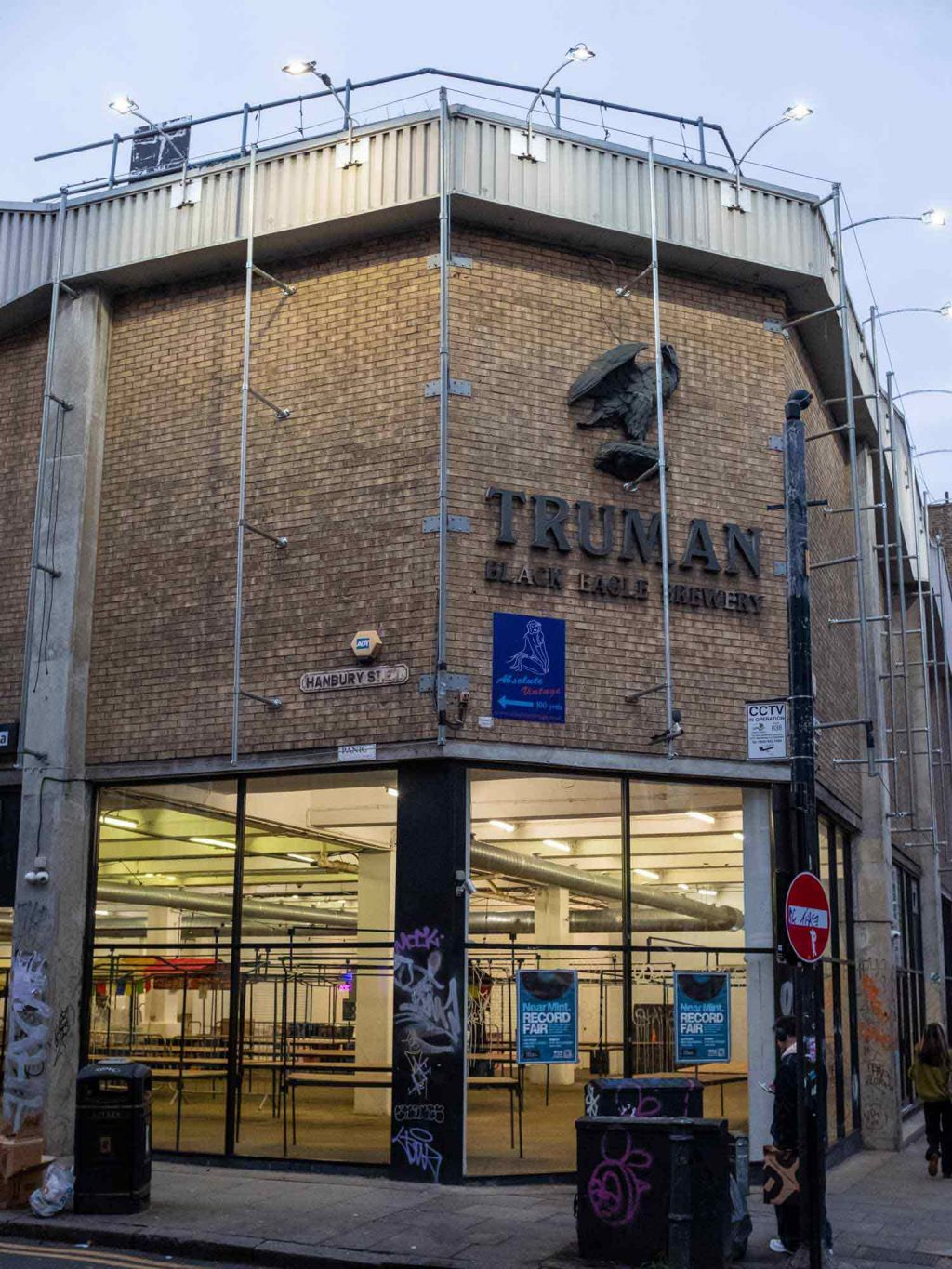
During the week it serves as a car park and on weekends it is transformed into Upmarket, an indoor market packed to the rafters with artisanal food traders, designer-makers and hurried tourists.
Continuing northward along Brick Lane, at the junction of Woodseer Street and Brick Lane, an unassuming low-rise brick wall emerges on the right-hand side behind which the brewery complex extends eastward as far as Spital Street.
The old brick wall ties in visually with the rest of Woodseer Street, a narrow road lined with Victorian terraced housing. The wall will soon give way to the gleaming glass of the contentious new-build commercial centre.
Passing under the Truman Bridge which marks the centre of this storied road, on your left you’ll see the cramped entrance to Dray Walk, a pedestrianised street crammed with bars, cafés, record shops, exhibition spaces, and offices stacked above.
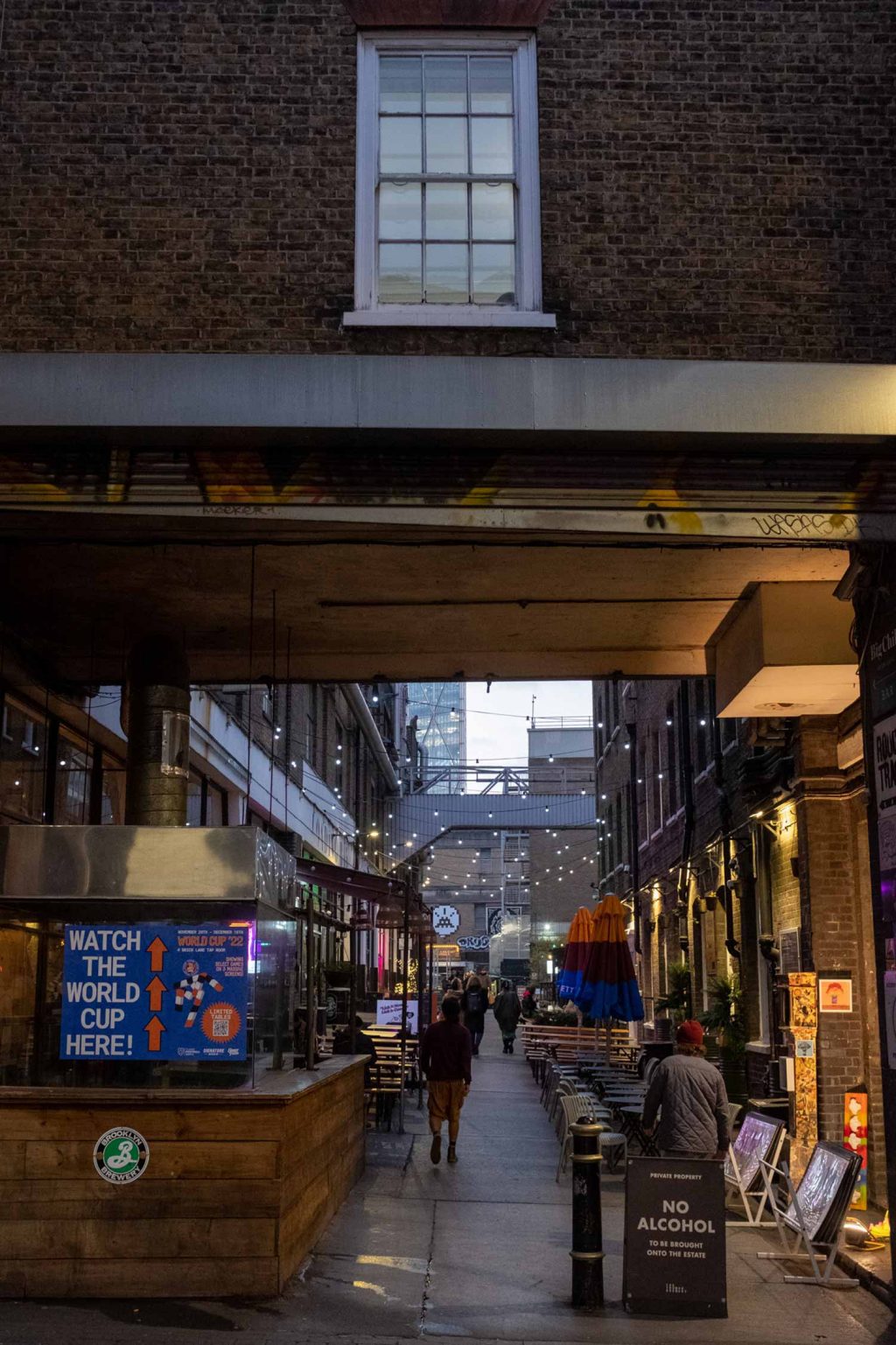
A detour down Dray Walk leads out onto the large open space known as Ely’s Yard, named after the patriarch of the Zeloof family who bought the brewery in 1995.
Food trucks, cabins and bars have set up shop throughout the vast yard, the perimeter of which is lined with ramshackle industrial buildings that have been converted into offices.
Back on Brick Lane, continuing northward to Bethnal Green, to your right you’ll encounter a colourful crew of arts and crafts pavement sellers clustered around the entrance to Tea Rooms and Backmarket, touting their wares to the heaving crowds that these indoor markets attract every weekend.
This is the Truman Brewery as described by their website – an oasis of exclusively independent traders, ”East London’s revolutionary arts and media quarter… home to a hive of creative businesses as well as exclusively independent shops, galleries, markets, bars, and restaurants.”
A stroll down the street seems to confirm the website’s vision of the estate, but a quick glance opposite the Tea Rooms’ doors reveals the more complex reality of the estate’s nature.
The 10,670 m2 faded yellow brick, European headquarters of multinational retail corporation Urban Outfitters, tucked in behind the Truman Bridge, attests to the estate’s little publicized corporate underbelly.
There is more evidence of the corporate aspect of the site to be found on Dray Walk, where three of London’s fifty-two data centres, run by Dutch tech giant Interxion take up 20,000 m2 of office space.
The brewery site is often thought of as a cradle of independent business, but the significant presence of corporations on the site challenges this over-simplistic idea of the brewery.
Continuing north past the Tea Rooms, you’ll reach the oldest part of the brewery, the embodiment of Brick Lane’s Victorian heritage.
To your right is the garlanded door to the bar and nightclub 93 Feet East, piercing an entrance through a solid and imposing Victorian building behind which are found the former stables and iconic chimney of the brewery. These spaces now host events and attract both night-time and daytime visitors.
To your left, behind the old iron railings, you’ll see the cobbled courtyard that provides a social space for the hundreds of people spilling out from the warren of office spaces that is Ninety One, Brick Lane. Beyond that, the brewery walls extend to the quiet backwaters of Quaker Street encompassing the bowling alley.
The brewery today teems with life, however, its resurrection as a central part of the local economy and the intense ‘regeneration’ of the area that it catalysed, was not wholly positive.
The area’s regeneration would prove to be a double-edged blade for the embedded working-class communities of Spitalfields and Banglatown, particularly those of Bangladeshi heritage, who compose 37% of the local population.
A policy of gentrification
For centuries, the culture and industry of Spitalfields and Banglatown have been defined by waves of immigrants; since the 1960s it has become the heartland of Bengali Britain.
The influx of the tech and creative industries in the early 90s and late noughties had brought a younger, whiter, more middle-class crowd to the then largely Bangladeshi and working-class community.
These arrivals transformed the local economy from Asian dining to an alcohol-fuelled late-night economy, with new bars springing up inside the brewery and in the northern end of Brick Lane and Shoreditch High Street.
Places like Vibe Bar were now thronged with creatives and young professionals, and a different stream of income flowed into the community.
What Camden was in the ’80s, an edgy hive of subcultural activity, Brick Lane became in the late ’90s and noughties – with the Truman Brewery at the core of this transformation.
But, as occurred in Camden, Brick Lane’s attainment of an edgy brand of cultural capital would invite a wave of higher-income residents and be followed by a radical process of ‘regeneration’, led by Tower Hamlets Council and the Mayor’s office.
The driving forces behind the gentrification of Western Tower Hamlets were the planning policies drawn up by the Greater London Authority and the local authority, a process which would ultimately deracinate many of the area’s embedded community.
The Mayor of London’s 2004 London Plan provided the vehicle for green-lighting another level of regeneration for Western Tower Hamlets. The plan identified dozens of ‘Opportunity Areas’ primarily located in deprived districts with the intention being to alleviate deprivation by attracting large-scale, higher-density private development to an area that might not get approval in other parts of the city.
The onslaught of large-scale development, including the £900 million redevelopment of Bishopsgate Goods Yard as well as the building of the £557 million 20 Bishops Square (the biggest commercial property deal in London in 2010) would be a key driving factor in Tower Hamlets becoming the most ‘gentrified’ borough in London between 2010 and 2016, according to race equality think-tank Runnymede Trust.
A report published by CLASS and Runnymede Trust in 2021 concluded that being designated as an ‘Opportunity Area’ (OA) increased gentrification and by implication population displacement, in deprived communities.
These luxury developments would push up property values, pricing many on low incomes out of the area, leaving Tower Hamlets with one of the highest rates of population change in the country.
The provision of opportunity areas, the report posited, allowed for high-density megadevelopments to be built which ‘’have the potential to remarkably alter the character of a given neighbourhood’’ and which were ‘’often not reflective of the housing needs of the local community.’’
The Runnymede survey also underlined how working-class and Black Minority Ethnic (BME) residents of opportunity area communities were inordinately impacted by gentrification.
Specific planning policy decisions at a local level were to have calamitous consequences for the embedded community of Tower Hamlets as well.
In 2007, the local council released its ‘City Fringe Area Action’ (CFAA) plan, which sought to provide directions on how development should be managed within Western Tower Hamlets. The CFAA designated Brick Lane a tourist area, marking the Truman Brewery for its ‘creative and cultural focus.’
For large sections of the community, the benefits brought to the street and its environs by mass tourism were drowned out by the related rise in rent.
By 2018, there were 15 Airbnb rentals estimated for every 100 properties on Brick Lane, placing severe strain on supply in the local rental market.
Working class and BME members of the embedded community are more likely to be renters and as such, the large British Bangladeshi community in and around Brick Lane bore the brunt of the rise in rent, with many longstanding locals priced out, according to the Runnymede survey.
The impact of the new luxury Tower Hamlets
The proliferation of large-scale corporate developments has seen property prices soar in Spitalfields and Banglatown, with prices tripling in the area around Brick Lane, between 2010 and 2020.
These megadevelopments, such as Bishopsgate and Bishops Square, had little provision of housing genuinely affordable to the embedded community in a borough with over 23,000 people on the waiting list for housing in April 2023.
As house prices and rent rose, there was a concomitant decline in long-standing local businesses, particularly businesses owned by the Bengali community, with a decrease of 62 per cent in curry houses from the mid-2000s to 2020.
The northern end of Brick Lane, once the domain of leather workshops, cash-and-carries, scrap-metal yards and bric-a-brac street stalls, which attracted a bargain-hunting clientele who frequented the Bengali and Punjabi eateries, was gradually transformed into a boujie district of high-end boutiques, trendy cafés and vintage clothes shops.
The prices demanded by these new shops, such as the infamous Cereal Killer café with its £3.20 bowls of cereal, disallowed the local working class from entering large swathes of the spaces on their street.
Gentrification has not only created class segregation in Spitalfields and Banglatown but also racial, with many of these spaces failing to cater for the needs of the local BME communities.
In the case of Brick Lane and its surrounding areas, numerous businesses to the north of the brewery fail to provide halal meat, and others rely on the sale of alcohol, excluding members of the local British Bengali community who adhere to Islam.
This wave of gentrification impinging on Brick Lane from the City and Shoreditch has been gradually washing down Brick Lane, transforming its northern reaches into a polished, upmarket district, attracting footfall at cultural odds with the Bangladeshi-dominated southern end of the street.
The ‘regeneration’ of the area, in reality, is simply banishing working class and BME citizens to the peripheries.
A strong contingent of curry houses and British-Bengali-owned shops, to the south of the brewery, have managed to hold out against this encroachment, yet they live staring down the barrel of an increasingly precarious future.
According to Runnymede, the ominous march of gentrification is ‘‘steadily encroaching south into the heart of Banglatown itself.’’
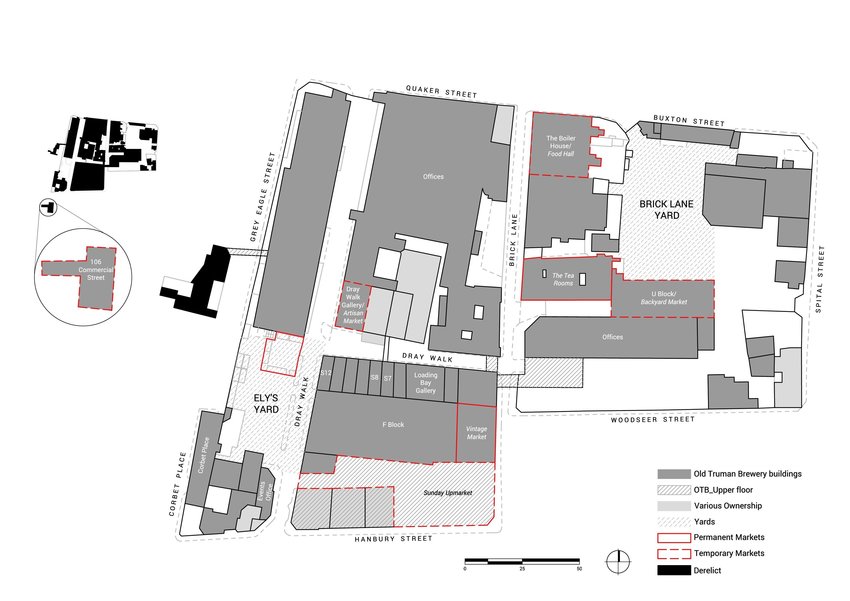
The Truman Brewery proposal
It is in this landscape that, on the 27th of February 2020, the gentrification of Brick Lane reached a dramatic crescendo.
The forces of ‘regeneration’, in the shape of another application for large-scale development, reached the very nucleus of Brick Lane and the edge of Banglatown.
The owners of the Truman Brewery had submitted a planning application that aimed to develop three large tracts of land amounting to an acre.
The proposal outlined a commercial development, ranging from two to five storeys in height on the empty site behind the brick wall that stretches the length of Woodseer Street, almost all the way to Spital Street. The proposal contained retail units on the ground floor as well as a gym and storage in a two-storey basement.
It also included the refurbishment, side extension and two-story upward extension of a building at 25 Woodseer Street, as well as a new restaurant within the Truman Bridge.
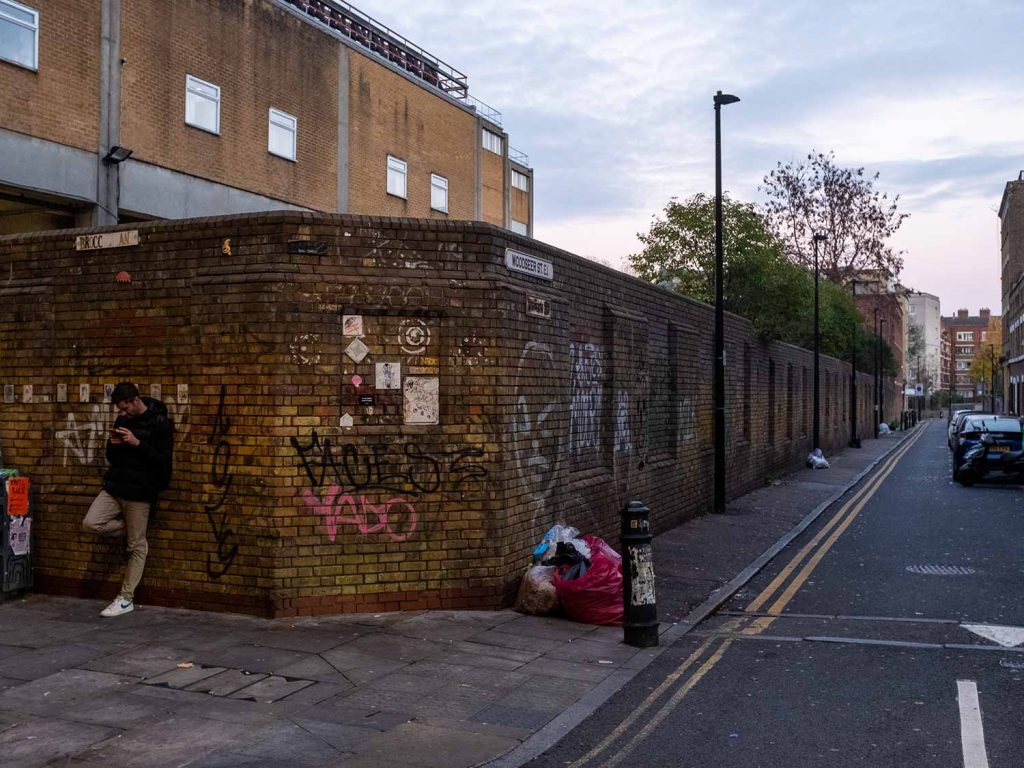
Additionally, a new street, New Dray Walk, would connect with the existing Dray Walk on the opposite side of Brick Lane with a new public square on the Eastern side of the site.
The creation of ‘’New Dray Walk’’ could disrupt the linear flow of traffic which has historically allowed shoppers to flow south to north along Brick Lane, corralling shoppers from the City.
Some traders in the area fear that the diversion of traffic away from the rest of Brick Lane will create a walled, parallel community of office workers and wealthier residents within the walls of the Truman Brewery, as well as City shoppers, syphoned from the west.
The decision on whether to allow the development was deferred on 27 April 2021, after Tower Hamlets Council members expressed concerns about whether the development would protect community interests, provide affordable workspace, and protect the interests of local businesses.
Officers and the applicant were to negotiate on these matters and return in mid-September to decide.
It wasn’t just the Council expressing reservations about the application though; vociferous opposition was mounting within the local community and further afield as well.
The opposition manifested itself in public campaigns, demonstrations, and the submission of 7,051 letters of objection to Tower Hamlets Council.
Objections flooded in from The Mayor’s Culture At Risk Office, Runnymede Trust, residents and businesses, local amenity groups and others from across the UK.
In a post-pandemic world, many doubted the need for over 3500sq metres of additional office floor space when workers are spending increasing amounts of time working from home.
Lambert Smith Hampton’s recent office market report, published in June of 2022 showed that up to a fifth of office space in London and south-east England may not be required in the post-pandemic world, raising doubts about the office block application, which was devised pre-pandemic.
Other letters of objection, including from The Mayor’s Culture at Risk Office, at Greater London Authority (GLA), expressed fears that the development would turbocharge the already increasing rent prices, further exacerbating the housing problem for the most vulnerable members of Tower Hamlets, a borough with a child poverty rate of 51%, the highest in the UK.
Additional concerns raised related to the level of consultation the community received, the impact that the scale and design of the development would have on the heritage assets of the building, as well as worries about the spread of the steel and glass architectural style of the City of London into the predominantly brick-built surrounding area.
The Battle for Brick Lane
The Save Brick Lane coalition, which launched in late 2020 and garnered reams of media coverage, orchestrated the community’s opposition to the development.
The coalition consisted of local residents and seven community groups: The Bengali East End Heritage Society, The Spitalfields Trust, Nijjor Manush, House of Annetta, East End Preservation Society, Spitalfields Life as well as the East End Trades Guild – an alliance of 350 small independent East End businesses..
The campaigners’ efforts were determined with dedicated locals volunteering hours of their time door knocking, protesting, and holding regular public meetings and information talks.
Community resistance also came in the form of street theatre, with residents and members of the coalition holding a mock funeral procession, pallbearers, and coffin in tow, to symbolise the impending death of the street at the hands of gentrification.
Online, the resistance’s charge has been led by Nijjor Manush, an independent UK Bengali campaigning group, one of their infographics receiving over 50,000 likes on Instagram.
Tasnima Uddin of Nijjor Manush explained how locals ‘’have been made to feel alien in the place they have long called home’’, and expressed her concern “that the redevelopment of the brewery will socially cleanse the area of the existing working-class communities that made Brick Lane world-renowned…’’
She went on to say that ‘’The owners of the Truman Brewery are the wealthiest landlords in Brick Lane, this development will continue to create their own world within Brick Lane… where only one family are profiting from every market.’’
The owners of the brewery, however, respond that the development will create several hundred new full-time jobs for locals, additional footfall for small businesses in the local economy as well as generate almost £2 million of additional business rate payments to the Council, annually.
Sentiment from local businesses in the area is conflicted, with some holding out hope that the development might bring the much-needed footfall that has recently been taken away – by this very type of mega-development.
One such supporter is Shams Uddin, the lively owner of Masala curry house on Brick Lane and the street’s longest-serving restaurateur. He claims that he ‘’is always with those who develop Brick Lane’’, believing it will bring him more customers.
When queried if he was worried about rents rising, Shams seems optimistic. ”Rent eventually is going to go higher… and nobody can stop that. If it’s good business, rent doesn’t matter” he reasoned.
Azmal Hussain, the owner of Preem, who is known locally as the Curry King, had the contrasting view that ‘’we’ll not get anything’’ from the office workers – who he believes will stay within the brewing complex – he posits that ‘’if they built houses, it would be good for local people.’’
Despite some qualified support from some local businesses, only 79 letters of support about the development were sent to the Council, and there has been little indication of wider support from an embedded community already suffering badly from population displacement.
Sitting in the quietude of Preem, where this evening, waiters outnumber customers and the rhythm of the rain beating softly against the window pane is heard where once the buzz of chattering tables would drown out all other noise, it’s easy to understand Azmal’s cynicism about the arrival of another office block.
However, the planning committee did not share his views and on the 14th of September 2021, in the deferred meeting, they went against the local outcry by approving plans for a colossal commercial retail complex in the heart of Brick Lane.
Cormac Kehoe has written this report as part of The Centre for Investigative Journalism’s Collaborative Community Journalism programme, which is funded by Trust for London.
In part two we look at controversies surrounding the decision-making process itself and explore the reasons why Councillors on the development committee dismissed the community’s backlash and allowed the redevelopment to go ahead.
Cormac Kehoe has written this report as part of The Centre for Investigative Journalism’s Collaborative Community Journalism programme, which is funded by Trust for London.

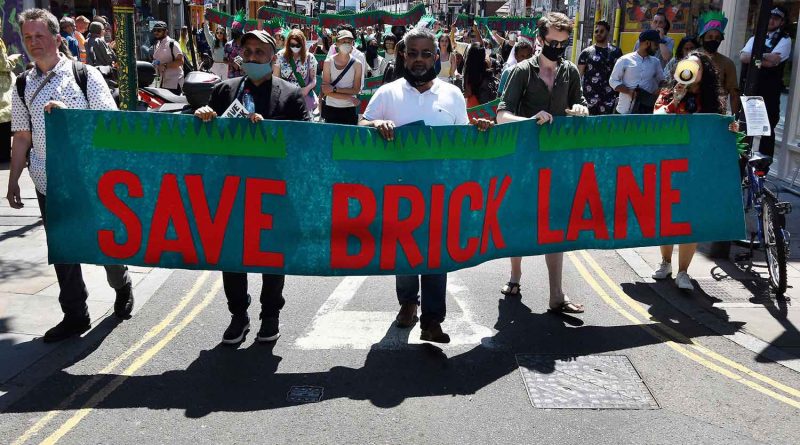
I understand that it is very convenient to live in an increasingly popular central London area for free or low money. I know the area well and I would love to live there too.
I find it however quite selfish, entitled and unfair to the rest to fight new developments in order to keep the area in the the derelict state it’s currently in for personal gain.
The east end has always undergone changes and so have it’s inhabitants changed over time – there have been large groups of people like Huguenots , Jews, Bengalis, Hipsters with all its own “ souls “ so why should we suddenly say no to further developments now ?
It’s about balance though, and these developments shouldn’t be excluding and pricing out the local community. It only serves to fuel disparity and division in society.
Up until quite recently, I lived not far from Brick Lane. Over the 8 years I lived there it is pretty startling how much the area had changed.
There’s very little evidence that new construction (increased supply) increases prices around it, and a lot that preventing building (limiting supply does)